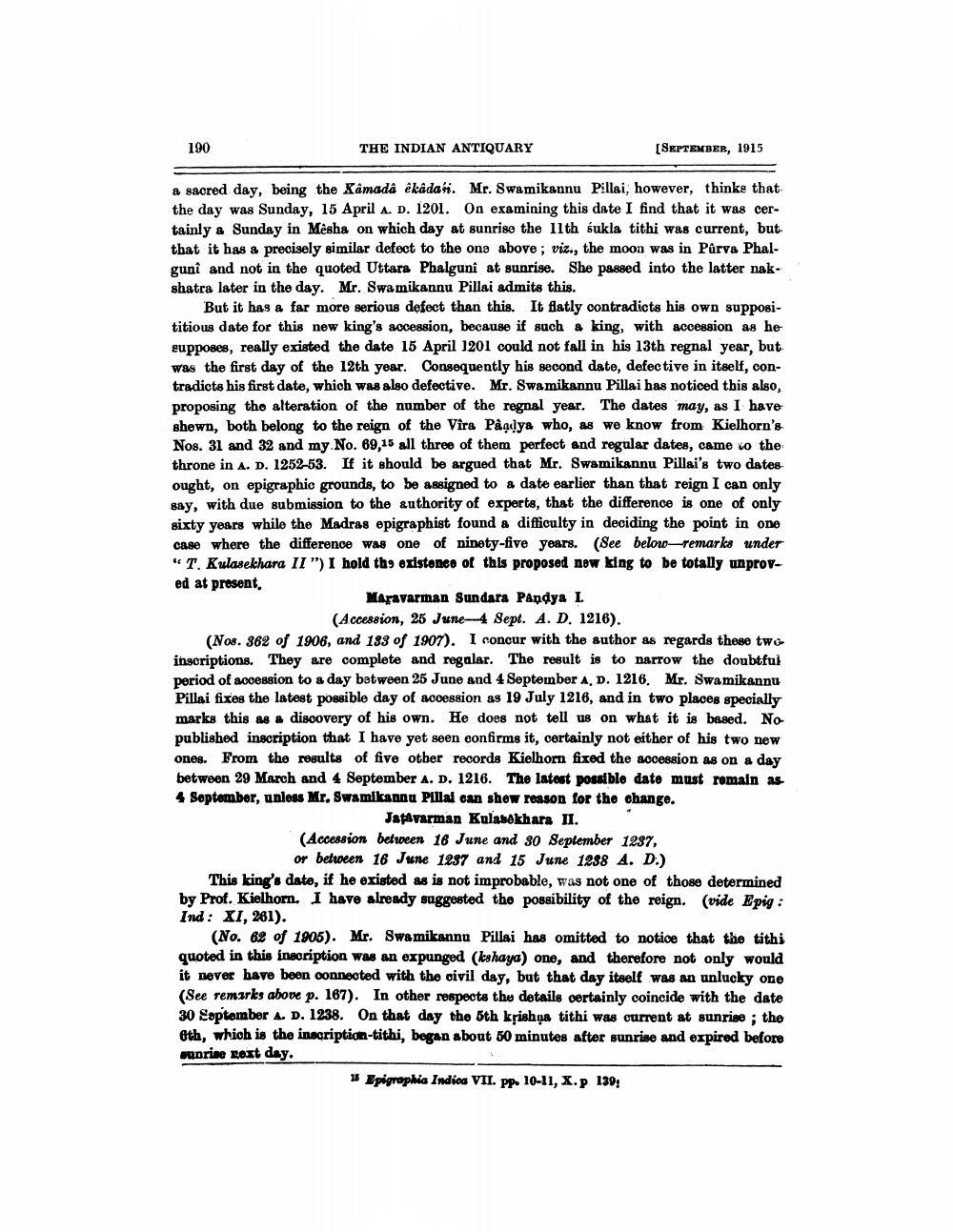________________
190
THE INDIAN ANTIQUARY
[SEPTEMBER, 1915
a sacred day, being the Xamada ekadasi. Mr. Swamikannu Pillai, however, thinks that the day was Sunday, 15 April A. D. 1201. On examining this date I find that it was certainly a Sunday in Mesha on which day at sunrise the 11th sukla tithi was current, but that it has a precisely similar defect to the one above; viz., the moon was in Pârva Phalguni and not in the quoted Uttara Phalguni at sunrise. She passed into the latter nak shatra later in the day. Mr. Swamikannu Pillai admits this.
But it has a far more serious defect than this. It flatly contradicts his own supposititious date for this new king's accession, because if such a king, with accession as he gupposes, really existed the date 15 April 1201 could not fall in his 13th regnal year, but was the first day of the 12th year. Consequently his second date, defective in itself, contradicts his first date, which was also defective. Mr. Swamikannu Pillai has noticed this also, proposing the alteration of the number of the regnal year. The dates may, as I have shewn, both belong to the reign of the Vira Pågdya who, as we know from Kielhorn's Nos. 31 and 32 and my No. 69,15 all three of them perfect and regular dates, came vo the throne in A. D. 1252-53. If it should be argued that Mr. Swamikannu Pillai's two dates ought, on epigraphic grounds, to be assigned to a date earlier than that reign I can only say, with due submission to the authority of experts, that the difference is one of only sixty years while the Madras epigraphist found a difficulty in deciding the point in one case where the difference was one of ninety-five years. (See below-remarks under "T. Kulasekhara II ") I hold the existence of this proposed now king to be totally unproved at present,
Maravarman Sundara Pandya L
(Accession, 25 June-4 Sept. A. D. 1216). (Nos. 362 of 1906, and 133 of 1907). I concur with the author as regards these two inscriptions. They are complete and regalar. The result is to narrow the doubtful period of accession to a day between 25 June and 4 September A, D. 1216. Mr. Swamikannu Pillai fixes the latest possible day of accession as 19 July 1216, and in two places specially marks this as a discovery of his own. He does not tell us on what it is based. No published inscription that I have yet seen confirms it, certainly not either of his two new ones. From the results of five other records Kielhorn fixed the accession as on a day between 29 March and 4 September A. D. 1216. The latest possible date must romain as 4 September, unless Mr. Swamikannu Pillal can show reason for the change.
Jatavarman Kulasekhara II. (Accession between 16 June and 30 September 1237,
or between 16 June 1297 and 15 June 1238 A. D.) This king's date, if he existed as is not improbable, was not one of those determined by Prof. Kielhorn. I have already suggested the possibility of the reign. (vide Epig: Ind: XI, 281).
(No. 62 of 1906). Mr. Swamikannu Pillai has omitted to notice that the tithi quoted in this inscription was an expunged (Ishaya) one, and therefore not only would it never have been connected with the civil day, but that day itself was an unlucky one (See remarks above p. 167). In other respects the details certainly coincide with the date 30 September A. D. 1238. On that day the 5th krishọa tithi was current at sunrise ; the 6th, which is the inscription-tithi, began about 50 minutes after sunrise and expired before munrise next day.
1 Epigraphia Indica VII. Pp. 10-11, X. p 139,




